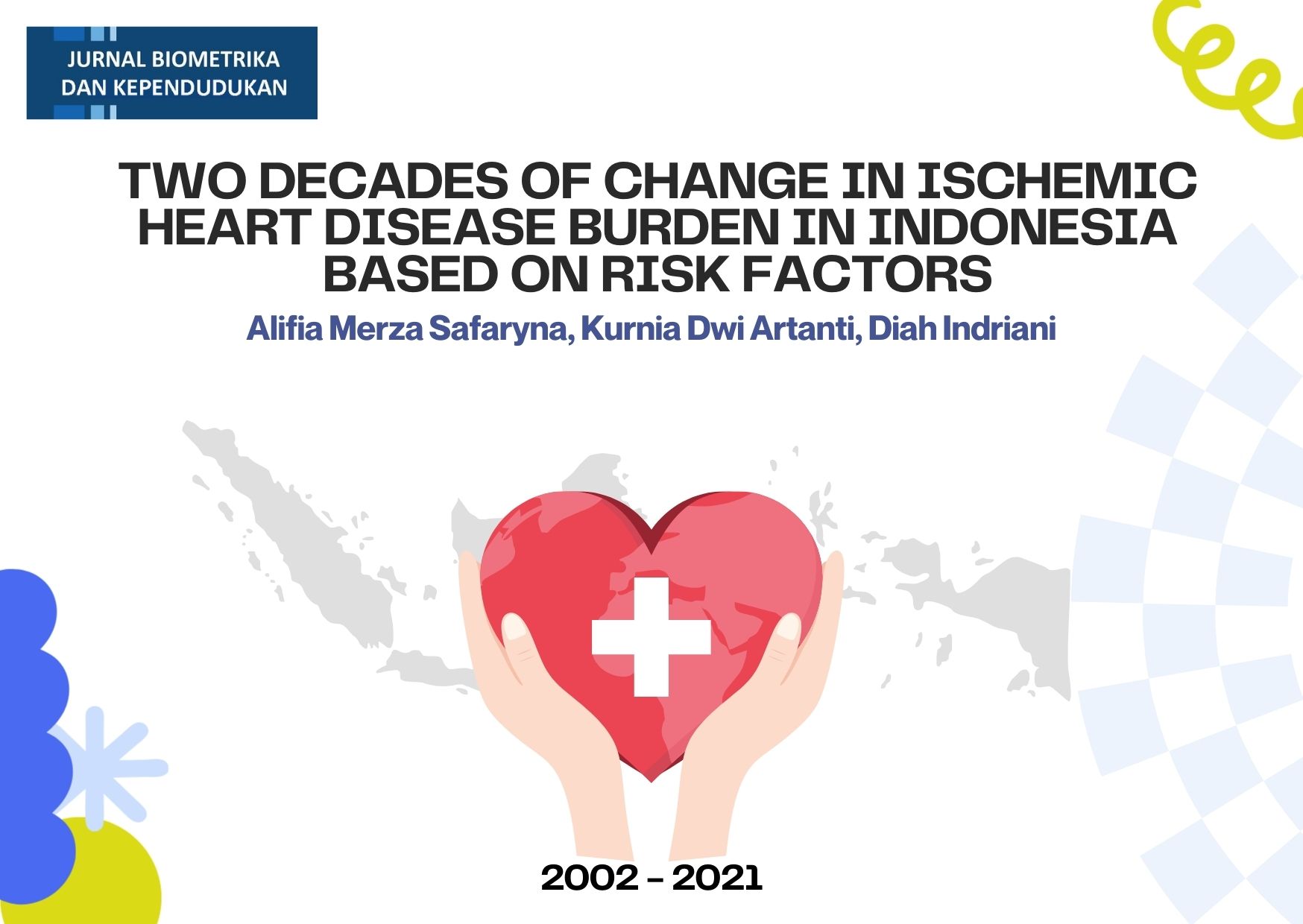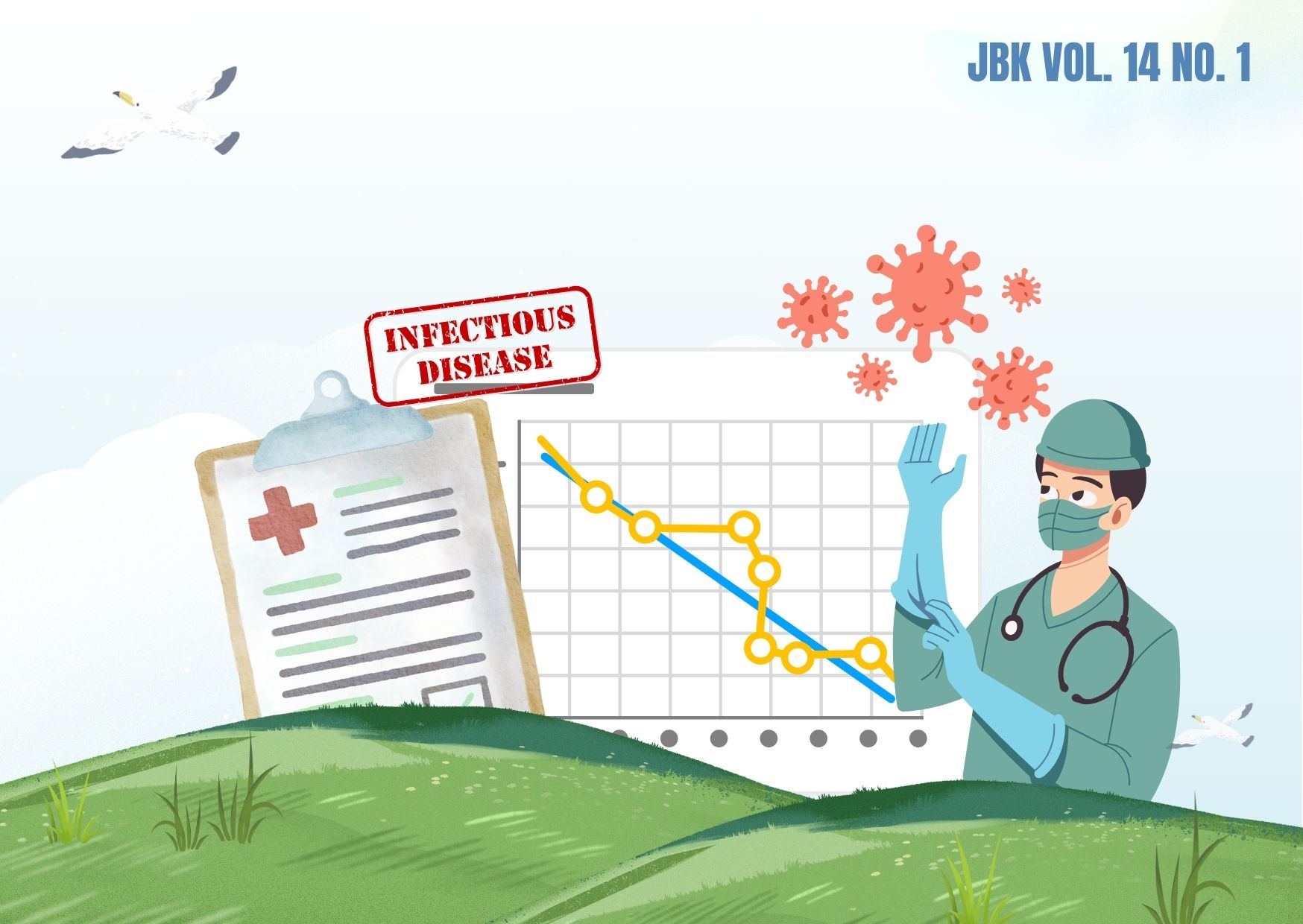TWO DECADES OF CHANGE IN ISCHEMIC HEART DISEASE BURDEN IN INDONESIA BASED ON RISK FACTORS

Downloads
The burden of ischemic heart disease (IHD), measured in disability-adjusted life years (DALYs), has significantly increased in Indonesia over the past two decades, indicating that current policies and programs have not been fully effective. This study aimed to analyze changes in the burden of IHD and its associated risk factors from 2002 to 2021 across 34 provinces in Indonesia, using secondary data from the Global Burden of Disease 2021. This cross-sectional analytical study used IHD-related DALYs as the dependent variable, and independent variables included non-optimal temperature, low physical activity, tobacco use, risky dietary patterns, air pollution, obesity, hypertension, high LDL cholesterol, and high fasting glucose. Descriptive statistics and linear regression were used, with Principal Component Analysis (PCA) applied to reduce multicollinearity. Separate regressions were conducted for 2002 and 2021 to assess changes over time. The results showed a 10.5% increase in IHD-related DALYs, from 2,753.87 per 100,000 population in 2002 to 3,043.08 in 2021. Hypertension emerged as the leading risk factor, followed by risky dietary patterns. Tobacco use and a principal component (low physical activity, risky dietary patterns, obesity, high LDL cholesterol, hypertension, and high fasting glucose) significantly contributed to the burden of IHD in both years. Environmental factors such as non-optimal temperature and air pollution did not show significant effects. Health programs must be strengthened with a focus on seven key risk factors contributing to IHD-related DALYs, especially modifiable ones like low physical activity, risky dietary patterns, and tobacco use to reduce IHD burden in Indonesia.
Shu J, Jin W. Prioritizing non-communicable diseases in the post-pandemic era based on a comprehensive analysis of the GBD 2019 from 1990 to 2019. Sci Rep [Internet]. 2023 Aug 16 [cited 2025 Jun 18];13(1):13325. Available from: https://doi.org/10.1038/s41598-023-40595-7
Dai H, Much AA, Maor E, Asher E, Younis A, Xu Y, et al. Global, regional, and national burden of ischaemic heart disease and its attributable risk factors, 1990–2017: results from the Global Burden of Disease Study 2017. Eur Heart J Qual Care Clin Outcomes [Internet]. 2022 Jan 5 [cited 2025 Jun 18];8(1):50–60. Available from: https://doi.org/10.1093/ehjqcco/qcaa076
Al-Ajlouni YA, Al Ta’ani O, Shamaileh G, Nagi Y, Tanashat M, Al-Bitar F, et al. The burden of Cardiovascular diseases in Jordan: a longitudinal analysis from the global burden of disease study, 1990–2019. BMC Public Health [Internet]. 2024 Mar 21 [cited 2025 Jun 18];24(1):879. Available from: https://doi.org/10.1186/s12889-024-18316-0
Schwend RM. The Burden of Pediatric Musculoskeletal Diseases Worldwide. Orthopedic Clinics of North America. 2020 Apr;51(2):207–17.
Ferrari AJ, Santomauro DF, Aali A, Abate YH, Abbafati C, Abbastabar H, et al. Global incidence, prevalence, years lived with disability (YLDs), disability-adjusted life-years (DALYs), and healthy life expectancy (HALE) for 371 diseases and injuries in 204 countries and territories and 811 subnational locations, 1990–2021: a systematic analysis for the Global Burden of Disease Study 2021. The Lancet. 2024 May;403(10440):2133–61.
Roth GA, Mensah GA, Johnson CO, Addolorato G, Ammirati E, Baddour LM, et al. Global Burden of Cardiovascular Diseases and Risk Factors, 1990–2019. J Am Coll Cardiol [Internet]. 2020 Dec [cited 2025 Jun 18];76(25):2982–3021. Available from: https://doi.org/10.1016/j.jacc.2020.11.010
Wu P, Yu S, Wang J, Zou S, Yao DS, Xiaochen Y. Global burden, trends, and inequalities of ischemic heart disease among young adults from 1990 to 2019: a population-based study. Front Cardiovasc Med [Internet]. 2023 Nov 24 [cited 2025 Jun 18];10. Available from: https://doi.org/10.3389/fcvm.2023.1274663
Shi H, Xia Y, Cheng Y, Liang P, Cheng M, Zhang B, et al. Global burden of ischaemic heart disease from 2022 to 2050: projections of incidence, prevalence, deaths, and disability-adjusted life years. Eur Heart J Qual Care Clin Outcomes [Internet]. 2024 Jun 25 [cited 2025 Jun 18]; Available from: https://doi.org/10.1093/ehjqcco/qcae049
Besnier F, Gayda M, Nigam A, Juneau M, Bherer L. Cardiac Rehabilitation During Quarantine in COVID-19 Pandemic: Challenges for Center-Based Programs. Arch Phys Med Rehabil [Internet]. 2020 Oct [cited 2025 Jun 18];101(10):1835–8. Available from: https://doi.org/10.1016/j.apmr.2020.06.004
Muharram FR, Multazam CECZ, Mustofa A, Socha W, Andrianto, Martini S, et al. The 30 Years of Shifting in The Indonesian Cardiovascular Burden—Analysis of The Global Burden of Disease Study. J Epidemiol Glob Health [Internet]. 2024 Feb 7 [cited 2025 Jun 18];14(1):193–212. Available from: https://doi.org/10.1007/s44197-024-00187-8
IHME. GBD Compare [Internet]. 2021 [cited 2023 Dec 10]. Available from: https://vizhub.healthdata.org/gbd-compare/
Li Y, Zhang J. Disease burden and risk factors of ischemic heart disease in China during 1990–2019 based on the Global Burden of Disease 2019 report: A systematic analysis. Front Public Health [Internet]. 2022 Nov 3 [cited 2025 Jun 18];10. Available from: https://doi.org/10.3389/fpubh.2022.973317
Ni W, Areal AT, Lechner K, Breitner S, Zhang S, Woeckel M, et al. Low and high air temperature and cardiovascular risk. Atherosclerosis. 2025 Jul;406:119238.
Mboi N, Syailendrawati R, Ostroff SM, Elyazar IR, Glenn SD, Rachmawati T, et al. The state of health in Indonesia’s provinces, 1990–2019: a systematic analysis for the Global Burden of Disease Study 2019. Lancet Glob Health. 2022 Nov;10(11):e1632–45.
Harmadha WSP, Muharram FR, Gaspar RS, Azimuth Z, Sulistya HA, Firmansyah F, et al. Explaining the increase of incidence and mortality from cardiovascular disease in Indonesia: A global burden of disease study analysis (2000–2019). PLoS One. 2023 Dec 15;18(12):e0294128.
Salam I, Widiyastuti R, Paulus AY, Butar MB, Sulistyawati, Mulyanti, et al. Epidemiologi Intermediate [Internet]. Akbar H, editor. Bandung: Media Sains Indonesia; 2024 [cited 2025 Mar 21]. i–214. Available from: https://eprints.uad.ac.id/63851/1/Buku%20Digital%20-%20EPIDEMIOLOGI%20INTERMEDIATE.pdf
Manullang S, Aryani D, Rusydah H. Analisis Principal Component Analysis (PCA) dalam Penentuan Faktor Kepuasan Pengunjung terhadap Layanan Perpustakaan Digilib. Edumatic: Jurnal Pendidikan Informatika [Internet]. 2023 Jun 20 [cited 2025 Jun 18];7(1):123–30. Available from: https://doi.org/10.29408/edumatic.v7i1.14839
Wang Y, Li Q, Bi L, Wang B, Lv T, Zhang P. Global trends in the burden of ischemic heart disease based on the global burden of disease study 2021: the role of metabolic risk factors. BMC Public Health [Internet]. 2025 Jan 24 [cited 2025 Jun 18];25(1):310. Available from: https://doi.org/10.1186/s12889-025-21588-9
Bowden Davies KA, Norman JA, Thompson A, Mitchell KL, Harrold JA, Halford JCG, et al. Short-Term Physical Inactivity Induces Endothelial Dysfunction. Front Physiol. 2021 Apr 9;12.
Dina C, Tit DM, Radu A, Bungau G, Radu AF. Obesity, Dietary Patterns, and Cardiovascular Disease: A Narrative Review of Metabolic and Molecular Pathways. Curr Issues Mol Biol. 2025 Jun 10;47(6):440.
Klein LW. Pathophysiologic Mechanisms of Tobacco Smoke Producing Atherosclerosis. Curr Cardiol Rev. 2022 Nov;18(6).
Kumar V, Vellapandian C. Unraveling the Nexus Between Ambient Air Pollutants and Cardiovascular Morbidity: Mechanistic Insights and Therapeutic Horizons. Cureus. 2024 Sep 4;
Desai Y, Khraishah H, Alahmad B. Heat and the Heart. Yale J Biol Med. 2023 Jun 30;96(2):197–203.
de Bont J, Jaganathan S, Dahlquist M, Persson Å, Stafoggia M, Ljungman P. Ambient air pollution and cardiovascular diseases: An umbrella review of systematic reviews and meta‐analyses. J Intern Med. 2022 Jun 8;291(6):779–800.
Khoshakhlagh AH, Mohammadzadeh M, Gruszecka-Kosowska A, Oikonomou E. Burden of cardiovascular disease attributed to air pollution: a systematic review. Global Health. 2024 May 3;20(1):37.
Cheng Q, Zhou S, Zhong H, Wang Z, Liu C, Sun J, et al. Global, regional, and national burden and risk factors of ischemic heart disease, 1990–2021: an analysis of the global burden of disease study. Front Public Health [Internet]. 2025 Apr 25 [cited 2025 Jun 18];13. Available from: https://doi.org/10.3389/fpubh.2025.1563631
Xu S, Liu Z, Tang M, Xu C. Burden, risk factors, and projections of ischemic heart disease in China (1990–2021): findings from the 2021 GBD study. Front Cardiovasc Med [Internet]. 2025 Feb 26 [cited 2025 Jun 18];12. Available from: https://doi.org/10.3389/fcvm.2025.1549147
Martín-Fernández J, Alonso-Safont T, Polentinos-Castro E, Esteban-Vasallo MD, Ariza-Cardiel G, González-Anglada MI, et al. Impact of hypertension diagnosis on morbidity and mortality: a retrospective cohort study in primary care. BMC Primary Care [Internet]. 2023 Mar 23 [cited 2025 Jun 18];24(1):79. Available from: https://doi.org/10.1186/s12875-023-02036-2
Lin W, Jiang X, Chen J, Yuan Y, Li Q, Wu H, et al. Global, regional and national burden of ischaemic heart disease attributable to high body mass index and low physical activity from 1990 to 2021. Diabetes Obes Metab [Internet]. 2025 May 18 [cited 2025 Jun 18];27(5):2561–72. Available from: https://doi.org/10.1111/dom.16256
Li H, Liang L, Song Z, Li Y. Global, regional, and national burden of cardiovascular disease attributable to high body mass index from 1990 to 2021 and projection to 2045. Front Endocrinol (Lausanne) [Internet]. 2025 Apr 28 [cited 2025 Jun 18];16. Available from: https://doi.org/10.3389/fendo.2025.1546176
Wang X, Zhou YF, Huang Z, Yu X, Chen Z, Cai Z, et al. Changes in Impaired Fasting Glucose and Borderline High Low-Density Lipoprotein-Cholesterol Status Alter the Risk of Cardiovascular Disease: A 9-Year Prospective Cohort Study. Front Cardiovasc Med [Internet]. 2022 Jun 21 [cited 2025 Jun 18];9. Available from: https://doi.org/10.3389/fcvm.2022.882984
Vaduganathan M, Mensah GA, Turco JV, Fuster V, Roth GA. The Global Burden of Cardiovascular Diseases and Risk. J Am Coll Cardiol [Internet]. 2022 Dec [cited 2025 Jun 18];80(25):2361–71. Available from: https://doi.org/10.1016/j.jacc.2022.11.005
Tan J, Xue M, Li H, Liu Y, He Y, Liu J, et al. Global, Regional, and National Burden of Ischemic Heart Disease Attributable to 25 Risk Factors and Their Summary Exposure Value Across 204 Countries With Different Socio-Demographic Index Levels, 1990–2021: A Systematic Fixed-Effects Analysis and Comparative Study. Clin Epidemiol [Internet]. 2025 Feb [cited 2025 Jun 18];Volume 17:105–29. Available from: https://doi.org/10.2147/CLEP.S510347
Shaya GE, Leucker TM, Jones SR, Martin SS, Toth PP. Coronary heart disease risk: Low-density lipoprotein and beyond. Trends Cardiovasc Med [Internet]. 2022 May [cited 2025 Jun 18];32(4):181–94. Available from: https://doi.org/10.1016/j.tcm.2021.04.002
Zhang Y, Pletcher MJ, Vittinghoff E, Clemons AM, Jacobs DR, Allen NB, et al. Association Between Cumulative Low-Density Lipoprotein Cholesterol Exposure During Young Adulthood and Middle Age and Risk of Cardiovascular Events. JAMA Cardiol [Internet]. 2021 Dec 1 [cited 2025 Jun 18];6(12):1406. Available from: https://doi.org/10.1001/jamacardio.2021.3508
Wang F, Mubarik S, Zhang Y, Shi W, Yu C. Risk assessment of dietary factors in global pattern of ischemic heart disease mortality and disability-adjusted life years over 30 years. Front Nutr [Internet]. 2023 Jun 14 [cited 2025 Jun 18];10. Available from: https://doi.org/10.3389/fnut.2023.1151445
Farcher R, Syleouni ME, Vinci L, Mattli R. Burden of smoking on disease-specific mortality, DALYs, costs: the case of a high-income European country. BMC Public Health [Internet]. 2023 Apr 14 [cited 2025 Jun 18];23(1):698. Available from: https://doi.org/10.1186/s12889-023-15535-9
Jain YK, Bhardwaj P, Joshi NK, Gupta MK, Goel AD, Sharma PP. Death, Disability, and Premature Life Years Lost Due to Cigarettes, Bidis, and Smokeless Tobacco in India: A Comparative Assessment. Addiction and Health [Internet]. 2023 Jan 29 [cited 2025 Jun 18];15(1):53–62. Available from: https://doi.org/10.34172/ahj.2023.1420
Brauer M, Roth GA, Aravkin AY, Zheng P, Abate KH, Abate YH, et al. Global burden and strength of evidence for 88 risk factors in 204 countries and 811 subnational locations, 1990–2021: a systematic analysis for the Global Burden of Disease Study 2021. The Lancet [Internet]. 2024 May [cited 2025 Jun 18];403(10440):2162–203. Available from: https://doi.org/10.1016/S0140-6736(24)00933-4
Vicedo-Cabrera AM, Tobias A, Jaakkola JJK, Honda Y, Hashizume M, Guo Y, et al. Global mortality burden attributable to non-optimal temperatures. The Lancet [Internet]. 2022 Mar [cited 2025 Jun 18];399(10330):1113. Available from: https://doi.org/10.1016/S0140-6736(22)00179-9
Wang X, Jiang Y, Bai Y, Pan C, Wang R, He M, et al.
Association Between Air Temperature and the Incidence of Acute Coronary Heart Disease in Northeast China
. Clin Interv Aging [Internet]. 2020 Jan [cited 2025 Jun 18];Volume 15:47–52. Available from: https://doi.org/10.2147/CIA.S235941Shrikhande SS, Pedder H, Röösli M, Dalvie MA, Lakshmanasamy R, Gasparrini A, et al. Non-optimal apparent temperature and cardiovascular mortality: the association in Puducherry, India between 2011 and 2020. BMC Public Health [Internet]. 2023 Feb 8 [cited 2025 Jun 18];23(1):291. Available from: https://doi.org/10.1186/s12889-023-15128-6
Copyright (c) 2025 Jurnal Biometrika dan Kependudukan

This work is licensed under a Creative Commons Attribution-NonCommercial-ShareAlike 4.0 International License.
Copyright©2022 Jurnal Biometrika dan Kependudukan (Journal of Biometrics and Population)
This work is licensed under a Creative Commons Attribution-NonCommercial-ShareAlike 4.0 International License.
1. Copyright of all journal manuscripts is held by the Jurnal Biometrika dan Kependudukan.
2. Formal legal provisions to access digital articles of the electronic journals are subject to the provision of the Creative Commons Attribution-ShareAlike license (CC BY-NC-SA), which means that Jurnal Kesehatan Biometrika dan Kependudukan to keep, transfer media/format, manage in the form of databases, maintain, and publish articles.
3. Published manuscripts both printed and electronic are open access for educational, research, and library purposes. Additionally, the editorial board is not responsible for any violations of copyright law.



































